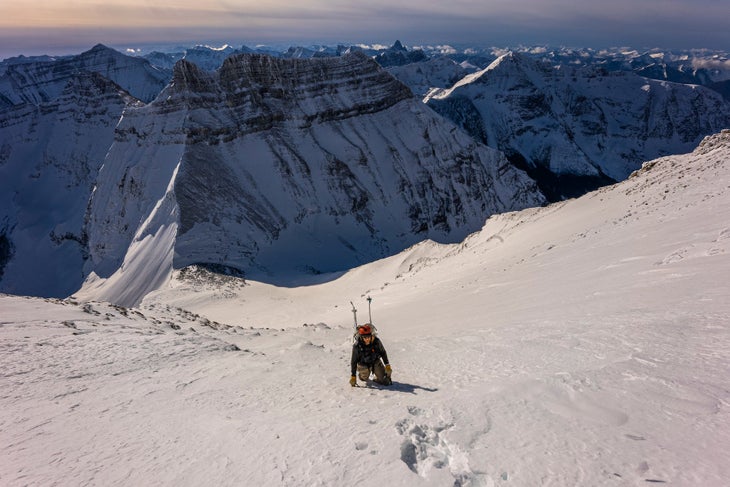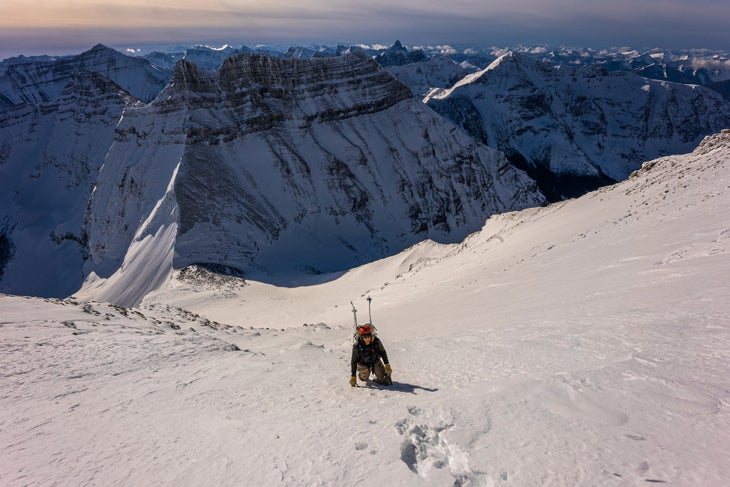No products in the cart.
Outdoor Adventure
Cody Townsend Should Quit “The Fifty” While He’s Ahead
The line before us didn’t seem all that intimidating—a subalpine couloir with walls that were almost more gully-like than a traditional, rocky pinner’s would be. But my two partners and I still paused for a solemn moment before dropping in that day. This was the Polichinelle Couloir, where Doug Coombs fell and died in 2006. I had moved to La Grave, France, for a season in my late 20s to follow in the tracks of giants like Coombs and learn to ski mountaineer. This is where I came to understand that the most deadly terrain is not found on the mountain but in the mind.
The trick with ski mountaineering is you can do everything right and still get it wrong. It’s like getting hit by a car; you never think it will happen to you. In Coombs’s case, a simple patch of ice above a cliff proved fatal. Yet, these stories haven’t deterred other professional freeriders from transitioning into ski mountaineering and thriving. Chris Davenport was one of the first, with his 14ers project. Snowboarder Jeremy Jones followed with his Deeper, Further, Higher trilogy. And today, some of the biggest skiing heroes are Christina Lustenberger, Jérémie Heitz, and Jimmy Chin.
Enter Cody Townsend, a big, blond, lovable personality with more downhill ski talent than just about anyone on Earth. After reaching the stupefying limits of his freeride career in 2014—when he won “Powder” magazine’s coveted Line of The Year award for flashing an impossibly tight, aesthetic couloir in Alaska—he found himself at a crossroads, contemplating what lay ahead. In the throes of ski mountaineering’s new pop appeal, he discovered a book Chris Davenport co-authored, “50 Classic Ski Descents of North America,” celebrating some of this continent’s most underground self-powered feats on skis. Townsend, who was not then a ski mountaineer, announced he would repeat every line in the book and launched “The Fifty,” a self-produced YouTube series documenting the process. Here we are five years later, with Townsend, an ice-axe-wielding viral sensation and only four lines remaining on his daunting list.
The problem now is he’s backed himself into a corner, and what’s left is insane. University Peak has only been skied a handful of times, Mount Robson and the Comstock Couloir twice, and Saint Elias has a short, messy history that’s sent two to their graves. Meanwhile, Townsend is at the height of his powers, with more eyes on him than ever. There are already many dangerous cultural trappings within ski mountaineering, like one-up-manship and summit fever. In Townsend’s case, these kinds of psychic traps are compounded by the pressure of his livelihood—not to mention being the sport’s biggest sweetheart. People love him and want him to succeed; I’m one of them. I love the show.
Sure, like any star, his reinvention has sometimes been cringey to watch. There’s been self-congratulation, like when he praises his own triage of a rescue on Mount Joffre. Or, there was the nail-biting near-miss on Mount Saint Elias, in which his team skis down a close-out line by mistake and hikes back out only minutes before a planet-shaking wet slide tears down it. Throughout the series, Townsend also regularly professes ski-mountaineering techniques or philosophies right after learning them himself. But then again, he’s found a winning formula that’s built him one of the biggest followings in skiing. And, more to his credit, he has indeed climbed and skied almost every line he set out to. Plus, he’s made a reasonable effort to show his mistakes, whether he understands them in the moment or not.
On that note, fans of the series will have noticed a change recently. Vulnerability and humility have become increasingly more genuine as he’s tackled the more complex lines on his checklist and wrestled more closely with death. In the Polar Star episode, for example, despite doing everything in perfect style and nailing a triumphant first descent, he narrowly misses being crushed by a random rockfall.

This is the handshake you make to ski these lines: much will be out of your control. As Townsend has run up against the edges of that contract, showy social-media vanity has all but disappeared from his episodes. Instead, he now reveals a tortured process of traveling for thousands of miles and days on end only to have to turn around, exhausted, as he tests the limits of his endurance at the tender age of 40. All for a project he may not enjoy as much as he once did.
Nonetheless, season five of “The Fifty” delivers a version of him operating at the top of his game. At this point, few could argue Townsend is anything less than a full-fledged ski mountaineer, and a good one at that. But if you know how confidence curves work, that is a terrible inflection point with four dangerous mountains left to go. Despite his success, there’s a risk of overconfidence, given the nature of the remaining descents. Townsend has skirted disaster enough times that the statistical truth of what’s ahead of him might be at odds with his expectations.
Still, there are differences between him and other ski-mountaineers. Most notably, he is one of the best skiers in the world. But that difference is also expressly what puts him at more risk. I’ve tried to ski Mount Robson twice and turned around each time because warming temperatures made it unsafe. That wasn’t easy for me, but it’ll be all the more difficult for him. If he chooses to walk in instead of using a helicopter, it takes at least two days to approach the mountain, let alone walk back out. The deeper you go, the more invested you feel. Like Saint Elias and University Peak, Robson has almost no beta available before you get there—you can take your best guess, but you find out the conditions once you arrive.
In the second Comstock Couloir episode, Greg Hill asks him if he would still be trying to get up it despite the fact it’s clagged in that day if it weren’t for the project. Townsend answers no, and it’s a perfect allegory for the entire élan of “The Fifty.” You’re in a bad place if the point is the objective, not the experience. Fate has stepped in to impress this fact on the very best. Not just Doug Coombs but also Andreas Fransson, Hillaree Nelson, and most recently, Tof Henry, to name but a few.
In my correspondence with Townsend, he told me he would not die for this project, and I believe he believes that. But he was clear he was going to try to finish. That said, he’s given himself no specific time frame and might not even film the last few lines (which is hard to believe). For many of us in the audience, however, his most impressive feats have not been brazen descents but when he’s wrestled with tough decisions. Backing off of the Comstock twice was painful but brilliant. Bailing on Saint Elias was precisely right (though executed poorly). And his patience and perseverance on Split was perfect. A lot of times, adversity is just as compelling, even if what you need to overcome is yourself.
Ski mountaineering is about listening and taking what’s on offer when it’s on offer. If he tunes into that, Townsend can bring his audience on any adventure he wants. But some lines left to go in “The Fifty” only come into shape a handful of times a decade. The chances of parachuting in from afar and nailing the conditions are too slim to quantify. How many years does he want to spend leaving his family to travel for days and weeks to test his willingness to turn around? He has grown so much and has our community’s respect, but I’m worried he still has to navigate the biggest hazard ski mountaineers face. Not crevasses, rock falls, or avalanches, but believing there’s only one ending to his story. In reality, he can write it any way he wants.
Matt Coté is a writer and editor who’s spent nearly two decades continually mesmerized by British Columbia’s peaks and people.
Source link

